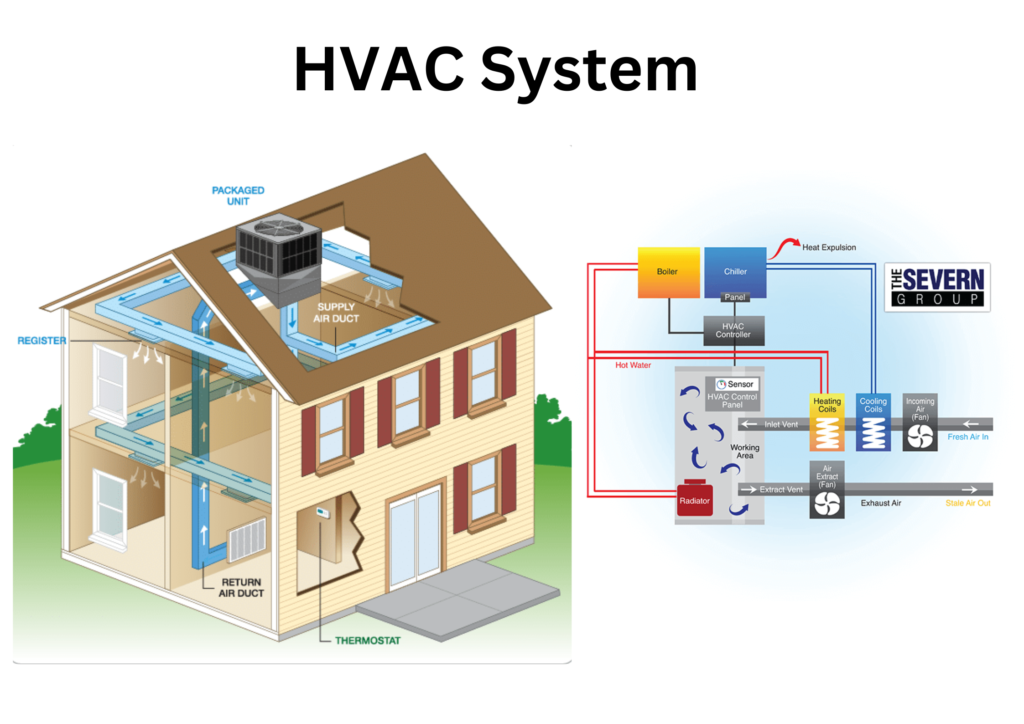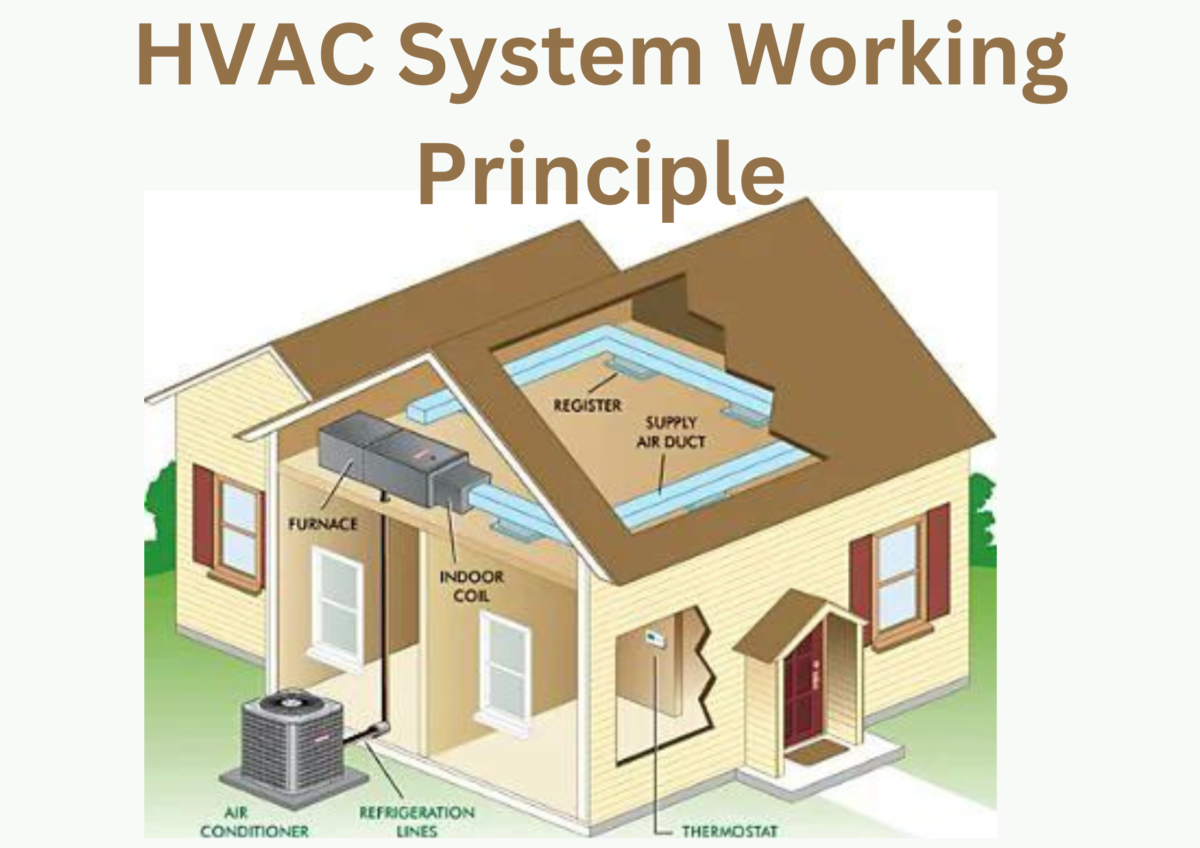HVAC systems are an essential part of large buildings, businesses, industrial locations, and homes which keep the indoor air comfortable and healthy. The presence of an HVAC system makes everyone out there feel comfortable and productive.
The HVAC system is used for atmospheric conditioning according to the requirements of the human body and the needs of the industrial conditions. So, you must know “What is an HVAC system?”, “HVAC system working principle”, types of HVAC systems, and the future trends of HVAC systems.
Read the full article to learn more about it.
What Is an HVAC System?
The abbreviation HVAC denotes heating, ventilation, and air conditioning. It is a complete home comfort system that is used to warm indoor spaces in the winter and keep them cool in the summer. The HVAC system also helps in improving indoor air quality through mechanical ventilation and filtration.
An HVAC system is an integrated setup, that is installed in indoor space for various tasks like heating, cooling, air quality control, moisture control, etc.
Some major components of the HVAC system include air filters, electronic heating elements, compressors, blowers, coils, exhaust outlets, air return setup, etc.

Types of HVAC System
Electric Furnace & Air Conditioner
In locations such as Texas or, Florida where warm weather exists, this type of HVAC system is perfect for a home. Most homes in the United States depend on the traditional combination of electric furnaces and air conditioners. The majority of these systems use gas furnaces whereas 5% of them utilize oil furnaces.
This system uses a blower motor inside the furnace to draw the air from the home’s interior. The conditioned air is then circulated back through ductwork.
The condensing unit of the air conditioner is usually located outside the house and the evaporator coil is accommodated within the furnace unit. This coil traps heat and expels it outside the house.
In this type of system, the air is heated or cooled based on the season and circulated back throughout the house through vents and ductwork.
Furnace & Heat Pump
These types of HVAC systems are dual fuel or, hybrid heat systems. These hybrid systems which combine both furnace and heat pump are mostly used in homes located in extremely cold climates.
During mild weather or, moderately cold conditions, the heat pump is activated which keeps the home comfortable. When the temperature falls below freezing, the heat pump becomes less sufficient and the gas furnace takes over automatically and offers additional heat.
Heat Pump Split System
In locations with mild weather heat pump split systems are often used. This type of HVAC system consists of a heat pump that supplies both the cool and hot air. Thus, it eliminates the requirement of a separate furnace or, an air conditioner.
The heat pump split system acts like an air conditioner during warm months and reverses its function in colder months.
This type of HVAC system is the most efficient option in places where electricity is the only energy source available. It is also the most energy-efficient heating and cooling option available for homes.
Geo Thermal Heat Pump
This type of HVAC system is highly energy efficient and environmentally friendly. A geothermal heat pump system transfers heat back and forth from the ground rather than the air outside. It creates heat from underground sources like soil and water to make the indoors comfortable.
This type of HVAC system does not generate heat from an energy source, to be more precise it is designed to move heat to maintain the desired temperature inside the house. Geothermal heat pump systems are expensive compared to other HVAC systems.
Ductless Mini-Split
This type of HVAC system is more popular nowadays. It is a type of air conditioning and heating system that offers hot and cool air throughout the year. It uses individual wall-mounted blowers that eliminate the need for any ductwork.
The units that are wall-mounted inside of your home have a built-in air handler. For whole home comfort, the outdoor units can be attached with multiple indoor air handlers.
Working Principle of HVAC System
HVAC systems are installed inside a home, a building, or, a confined space for various purposes such as to control temperature, humidity, air quality, etc. The main objective of this device is to maintain the ambient temperature either by heating or, cooling, to maintain the optimal humidity level, and to improve the air quality.
The main components of an HVAC system include

Thermostat: This device is used to monitor the indoor temperature and control the system’s operation to maintain the desired temperature level of the room.
Furnace/Heat Pump: A furnace is a traditional device that burns oil or, natural gas to produce heat. Heat pumps do not require any fuel source to produce heat, rather they extract heat from the ground, outdoor air, or by electricity and refrigerant to transfer it indoors.
Air conditioner: It cools the air inside the home by eliminating moisture or, heat from it. It uses a refrigerant to execute this process.
Blower motor: It manages and circulates the hot and cold air inside the room. The air being pushed out from the system is circulated back inside the home through a blower motor.
Condenser coil: It is placed outside the home. It removes heat from the refrigerant that it absorbs from the inside.
Evaporator Coil: It is located inside the furnace or in your AC unit’s air handler. It absorbs heat from the home.
Air ducts or vents: Air ducts control the airflow and serve as the pathway for conditioned air. Air vents are the visible outlets that make sure the conditioned air circulates inside the living spaces efficiently.
The working principle of an HVAC system is explained below.
Air heating:
The heating or cooling procedure of an HVAC system is based on the principle of heat transfer from a warmer object to a cooler object. When the user needs to heat the room, the heating unit of the HVAC system is activated. This unit makes use of heating elements like an electronic heater, or induction coil, or, burns fuel to generate the heat.
The air extracted from the room is forced through the heat and the warm air circulates back throughout the building or home to increase the ambient temperature.
Air Cooling:
The cooling unit of the HVAC system is activated, to cool the room. Inside the cooling unit, the warm air is passed through the refrigerant coil which is a cross-flow coil type. The refrigerant extracts the heat from the warm air and supplies the cooled air inside the room.
The cooling unit also contains the compressor which compresses the refrigerant into a smaller volume, increases its temperature and pressure, and also liquifies the refrigerant.
Humidity control:
The air conditioning system is designed to control the humidity level of the room. When the warm air passes through the refrigerant coils, the heat is extracted by the refrigerant and moisture drops out of the air. Thus an HVAC system removes the humidity or moisture from the air.
Air Quality Control:
AN air filter is placed between the air return setup and the blower motor of an HVAC system. The air filter eliminates harmful airborne particles like dust, bacteria, pollen, pet dander, etc., and supplies the purified air inside the room. This improves the air quality and makes the air healthy to breathe.
Future Trends in HVAC technology
Connected HVAC
IoT connects HVAC systems to a network and this enables users to connect the HVAC system to other smart electronic devices and appliances to communicate within the network. This type of HVAC system supports precise adjustment and optimization. It also improves operation, increases efficiency, and reduces the operational cost.
A connected HVAC system includes smart sensors, thermostats, air conditioner controllers, plug controllers, etc.
Eco-Friendly HVAC System
The demand for eco-friendly HVAC systems is increasing day by day. It reduces the use of petroleum-based electricity. The most common eco-friendly HVAC system is the geothermal heating and cooling method. This type of system uses ground or, water sources to create energy to heat and cool the buildings.
Renewable Integration
Nowadays the demand for sustainable building is increasing rapidly. These buildings use a combination of renewable energy sources and an HVAC system which reduces their carbon footprint. The HVAC systems become energy-independent by integrating with renewable energy sources like solar energy, wind energy, geothermal energy, etc. This leads to high energy efficiency, low operational cost, and a greener future.
Ductless HVAC System
The installation of ductwork is expensive, time-consuming, and space-consuming. So, instead of installing ductwork the advanced HVAC systems implement individual air-handling units which are connected to outdoor condenser units.
This technology allows users to monitor and regulate the temperature of individual rooms. This ensures personalized comfort, saves energy, reduces installation complexity, reduces maintenance costs, and also helps in upgrading the indoor air quality.
Precision Indoor Climate Control
The integration of digital monitoring devices and management tools with the HVAC system leads to precise indoor climate control solutions. This advanced technology allows users to continuously monitor and regulate the indoor temperature, and relative humidity level. Thus, it ensures consistent comfort to the users.
Conclusion
The HVAC system provides heat, ventilation, and air conditioning to manage the indoor environment and air quality. Digital innovations in the HVAC industry lead to energy savings, reduced operational costs, and decreased energy consumption. From geothermal heat pumps to solar-powered air conditioning systems, to the integration of renewable energy sources into the HVAC system, all of these give a clear vision toward a greener and sustainable feature.
FAQS
- What is the basic concept of an HVAC system?
The basic concept of an HVAC system is to offer the desired temperature, optimal humidity level, and optimum air quality inside the home or a building.
2. What are HVAC parts?
The main components of an HVAC system include a thermostat, furnace/heat pump, air conditioner, condenser coil, blower motor, evaporator coil, air ducts, or, vents.
Also Read
- HVAC System Vs Air Conditioning System: 6 Major Differences
- What Are the Most Common Types of HVAC Systems? 2024
- 6 Types of HVAC Systems for Homes 2024
- How Does a Refrigerator Work? A Step-by-Step Guide 2024
- 8 Reasons Why Refrigerator Not Cooling and Solutions
- Side By Side Vs French Door Refrigerator 2024
- Counter Depth Refrigerator vs. Standard Refrigerator: Which One Is Better?
- Where Should I Place My Air Purifier? 2024
- How Do You Know If You Need an Air Purifier? 2024
- HEPA Air Purifier: Definition, Types, Uses, Efficiency, Working Principle
- Whole House Air Purifier: Types, Pros, Cons, Working Principle 2024
- Air Purifier Advantages and Disadvantages
- How Do Air Purifiers Help? 6 Benefits
- Whole House Dehumidifier: Types, Working Principle, Pros, Cons 2024
- How Does a Commercial Dehumidifier Work? 2024
- How Does a Dehumidifier Work? Types, Uses, Benefits 2024
- 10 Tips for Buying a Dehumidifier
- Dehumidifier Vs Air Purifier 2024
- Dehumidifier vs. Air Conditioner 2024
- Cool Mist Humidifier: Types, Uses, Benefits, Working Principle 2024
- Do Humidifiers Help with Air Quality? 2024
- When Do You Need a Humidifier? 8 Common Signs
- How Do Humidifiers Work? A Complete Guide 2024
- How Humidifier Helps Breathing? 2024
- Humidifier Vs Dehumidifier Vs Air Purifier: Which One Should You Buy? 2024


11 thoughts on “HVAC System Working Principle And The Future Trends 2025”